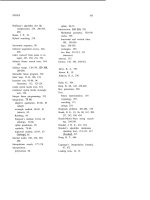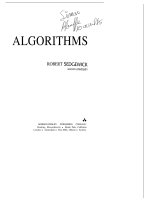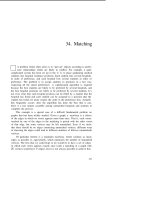Tài liệu Thuật toán Algorithms (Phần 48) docx
Bạn đang xem bản rút gọn của tài liệu. Xem và tải ngay bản đầy đủ của tài liệu tại đây (155.43 KB, 10 trang )
ALGORITHM
463
A I A L B M E M E P E X
A
X
A
X
A
X
BAEEEGGIMLMNRP’X
A
A
Surprisingly, in this representation each “split-and-interleave” operation re-
duces to precisely the same interconnection pattern. This pattern is called
the perfect because the wires are exactly interleaved, in the same way
that cards from the two halves would be interleaved in an ideal mix of a deck
of cards.
This method was named the odd-even merge by K. E. Batcher, who
invented it in 1968. The essential feature of the method is that all of the
compare-exchange operations in each stage can be done in parallel. It clearly
demonstrates that two files of N elements can be merged together in
parallel steps (the number of rows in the table is halved at every step), using
less than N log N compare-exchange boxes. From the description above, this
might seem like a straightforward result: actually, the problem of finding such
a machine had stumped researchers for quite some time.
Batcher also developed a closely related (but more difficult to understand)
merging algorithm, the merge, which leads to an even simpler machine.
464
CHAF’TER 35
This method can be described in terms of the “split-and-interleave” operation
on tables exactly as above, except that we begin with the second file in reverse
sorted order and always do compare-exchanges between vertically adjacent
items that came from the same lines. We won’t go into the proof that this
method works: our interest in it is that it removes the annoying feature in the
odd-even merge that the compare-exchange boxes in the first stage are shifted
one position from those in following stages. As the following diagram shows,
each stage of the merge has exactly the same number of comparators,
in exactly the same positions:
AEGGIMNRXPMLEEBAAEGGIMNRXPMLEEBA
AXEPGMGLIEMENBRAAXEPGMGLIEMENBRA
AXEPGMGLEIEMBNARAXEPGMGLEIEMBNAR
ABEGIMXNEAEGMLPRABEGIMXNEAEGMLPR
I I
AABEEEGGILMMNPRXAABEEEGGILMMNPRX
Now there is regularity not only in the interconnections but in the positions of
the compare-exchange boxes. There are more compare-exchange boxes than
for the odd-even merge, but this is not a problem, since the same number
of parallel steps is involved. The importance of this method is that it leads
directly to a way to do the merge using only N compare-exchange boxes. The
ALGORITHM MACHINES 465
idea is to simply collapse the rows in the table above to just one pair of rows,
and thus produce a cycling machine wired together as follows:
Such a machine can do log N compare-exchange-shuffle “cycles,” one for each
of the stages in the figure above.
Note carefully that this is not quite “ideal” parallel performance: since
we can merge together two files of N elements using one processor in a number
of steps proportional to N, we would hope to be able to do it in a constant
number of steps using N processors. In this case, it has been proven that it
is not possible to achieve this ideal and that the above machine achieves the
best possible parallel performance for merging using compare-exchange boxes.
The perfect shuffle interconnection pattern is appropriate for a variety of
other problems. For example, if a square matrix is kept in row-major
order, then perfect shuffles will transpose the matrix (convert it to
major order). More important examples include the fast Fourier transform
(which we’ll examine in the next chapter); sorting (which can be developed by
applying either of the methods above recursively); polynomial evaluation; and
a host of others. Each of these problems can be solved using a cycling perfect
shuffle machine with the same interconnections as the one diagramed above
but with different (somewhat more complicated) processors. Some researchers
have even suggested the use of the perfect shuffle interconnection for
purpose” parallel computers.
466
CHAPTER 35
Systolic Arrays
One problem with the perfect shuffle is that the wires used for interconnection
are long. Furthermore, there are many wire crossings: a shuffle with wires
involves a number of crossings proportional to These two properties turn
out to create difficulties when a perfect shuffle machine is actually constructed:
long wires lead to time delays and crossings make the interconnection expen-
sive and inconvenient.
A natural way to avoid both of these problems is to insist that processors
be connected only to processors which are physically adjacent. As above, we
operate the processors synchronously: at each step, each processor reads inputs
from its neighbors, does a computation, and writes outputs to its neighbors.
It turns out that this is not necessarily restrictive, and in fact H. T. Kung
showed in 1978 that arrays of such processors, which he termed systolic arrays
(because the way data flows within them is reminiscent of a heartbeat), allow
very efficient use of the processors for some fundamental problems.
As a typical application, we’ll consider the use of systolic arrays for
matrix-vector multiplication. For a particular example, consider the matrix
operation
This computation will be carried out on a row of simple processors each of
which has three input lines and two output lines, as depicted below:
Five processors are used because we’ll be presenting the inputs and reading
the outputs in a carefully timed manner, as described below.
During each step, each processor reads one input from the one from
the top, and one from the right; performs a simple computation; and writes
one output to the left and one output to the right. Specifically, the right
output gets whatever was on the left input, and the left output gets the result
computed by multiplying together the left and top inputs and adding the right
input. A crucial characteristic of the processors is that they always perform a
dynamic transformation of inputs to outputs; they never have to “remember”
computed values. (This is also true of the processors in the perfect shuffle
machine.) This is a ground rule imposed by low-level constraints on the
467
hardware design, since the addition of such a “memory” capability can be
(relatively) quite expensive.
The paragraph above gives the “program” for the systolic machine; to
complete the description of the computation, we need to also describe exactly
how the input values are presented. This timing is an essential feature of the
systolic machine, in marked contrast to the perfect shuffle machine, where
all the input values are presented at one time and all the output values are
available at some later time.
The general plan is to bring in the matrix through the top inputs of the
processors, reflected about the main diagonal and rotated forty-five degrees,
and the vector through the left input of processor A, to be passed on to the
other processors. Intermediate results are passed from right to left in the
array, with output eventually appearing on the left output of processor
A. The specific timing for our example is shown in the following table, which
gives the values of the left, top, and right inputs for each processor at each
step:
ABCDE ABCDE
ABCD
1 1
2 1
3 5 1
1
4 5 1 3 1
1
5 2 5 1 -4 1 -1 16 1
6
2 5
-2 -2 8 6 -1
7
2 5
5
2
-11
8
2
2 -1
9
2 -1
10
-1
The input vector is presented to the left input of processor A at steps 1, 3,
and 5 and passed right to the other processors in subsequent steps. The input
matrix is presented to the top inputs of the processors starting at steps 3,
skewed so the diagonals of the matrix are presented in successive
steps. The output vector appears as the left output of processor A at steps
6, 8, and 10. (In the table, this appears as the right input of an imaginary
processor to the left of A, which is collecting the answer.)
The actual computation can be traced by following the right inputs (left
outputs) which move from right to through the array. All computations
produce a zero result until step 3, when processor C has 1 for its left input
and 1 for its top input, so it computes the result 1, which is passed along









